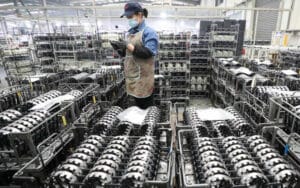Contrary to recent headlines, the increase in production from new global refineries is not expected to impact margins for key products this year. This analysis comes from Goldman Sachs, which suggests that these projects will take several additional quarters or even years to realize their full potential.
In recent months, there has been much speculation about the imminent startup of two major refineries. These include the 650,000 b/d Dangote refinery in Nigeria and the 340,000 b/d Dos Bocas facility in Mexico. However, Goldman Sachs refutes press reports suggesting that both plants will soon ramp up production.
The reality is that until there are a significant number of electric vehicles on the roads, the demand for traditional fuels will continue to be tied to population growth. Therefore, the game will not change until EV adoption reaches critical mass.
Acknowledging the media hype surrounding the Nigerian and Mexican refineries, Goldman analysts remain skeptical about their immediate ramp-up plans. While there have been reports of “test runs” at Dangote and promises by the CEO of Mexican state-owned oil company Pemex about Dos Bocas reaching full utilization in March, Goldman highlights the lack of sufficient crude oil reserves for consistent operation. Despite having 6 million bbl of crude in storage at the Dangote complex, this only covers about 9 days’ worth of needs.
In conclusion, although the anticipation for these state-of-the-art refineries is high, it will take time for them to have a substantial impact on the market. In the meantime, refinery margins are expected to hold steady until there is a significant shift towards electric vehicles.
Refinery Delays and Long-Term Implications
The Pemex refinery is facing challenges as only one of its two crude oil distillation units is expected to be operational. A recent report, based on Goldman’s equity research spanning a decade, sheds light on the matter. The analysis focused on 100 individual CDUs, accounting for approximately 15 million barrels per day (b/d) of the world’s total refining capacity.
According to the study, newly commissioned equipment often encounters significant delays, with refineries slated to commence operations within a year taking an average of two years to become fully functional. Underestimating the complexities related to crude supply logistics, final mile infrastructure, and successful testing for new greenfield facilities exacerbates this predicament.
One instance that exemplifies these challenges is the Jizan refinery in Saudi Arabia. Although it started operating in 2021, it took an additional two years before reaching its maximum capacity.
Goldman’s research suggests that most newly established refineries should anticipate equipment start-ups to exceed projected timelines by at least five months. Furthermore, from the onset of construction to fuel provision, most refineries require more than eight years before commencing production. Therefore, units currently listed as “planned” will not become operational until 2028.
The report concludes that elongated intervals between investments and downstream returns, coupled with significant demand uncertainties, hinder the notion that “high prices cure high prices.” Furthermore, considering the existing 3 million b/d deficit in mid-cycle refining capacity, refining margins are expected to remain strong.
